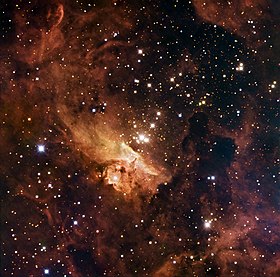Pismis 24-1
 Pismis 24-1 is the brightest point of light at the centre of this optical image of the NGC 6357 region. Credit: ESO/IDA/Danish 1.5 m/ R. Gendler, U.G. Jørgensen, J. Skottfelt, K. Harpsøe | |
| Observation data Epoch J2000 Equinox J2000 | |
|---|---|
| Constellation | Scorpius |
| NE | |
| Right ascension | 17h 24m 43.497s[1] |
| Declination | –34° 11′ 56.86″[1] |
| Apparent magnitude (V) | 11.00[2] |
| SW | |
| Right ascension | 17h 24m 43.481s[1] |
| Declination | –34° 11′ 57.21″[1] |
| Apparent magnitude (V) | 11.10[2] |
| Characteristics | |
| NE | |
| Spectral type | O3.5If*[3] |
| Variable type | eclipsing[4]
|
| SW | |
| Spectral type | O4III(f+)[3] |
| Absolute magnitude (MV) | −7.50[3] |
| NE | |
| Absolute magnitude (MV) | −6.41[4] |
| SW | |
| Absolute magnitude (MV) | −6.28[4] |
| Details | |
| NE | |
| Mass | 74[1] M☉ |
| Radius | 18 R☉ |
| Luminosity | 776,000[1] L☉ |
| Temperature | 42,500/41,500[4] K |
| SW | |
| Mass | 66[1] M☉ |
| Radius | 17 R☉ |
| Luminosity | 646,000[1] L☉ |
| Temperature | ~40,000[1] K |
Pismis 24-1SW, HD 319718B | |
| Database references | |
| SIMBAD | data |
Pismis 24-1, also known as HD 319718, is the brightest
Discovery
Pismis 24-1 was first catalogued as HD 319718, later resolved into both Pismis 24-1 and the fainter
In 1973, Pismis 24 was resolved into 15 components of which 12 were considered member stars. The brightest was numbered first as Pismis 24-1 and tentatively considered a
System

Pismis 24-1 has been resolved visually into two components, usually labelled as NE and SW from their orientation with each other.
Pismis 24-1NE is slightly more luminous and hotter than 24-1SW, but is known to be a spectroscopic binary.
Pismis 24-1 is actually a shallow
The
Properties

The two components of Pismis 24-1NE cannot be detected separately, but analysis of their
Pismis 24-1SW is apparently a single star with a spectral type of O4 III(f+), indicating a temperature around 40,000 K and emission lines of ionised nitrogen, silicon and helium. The luminosity is around 650,000 L☉, the radius 17 R☉, and the mass 66 M☉. It is classified as a giant star on the basis of its spectrum, but the hottest O stars develop these spectral features while still burning hydrogen in their cores, as a result of vigorous convection and powerful stellar winds.[4]
When first modelled, Pismis 24-1 was thought to be a single star with a mass of 300 M☉ or more, higher than expected to be theoretically possible. This estimate has decreased as the star was discovered to be a binary, then a triple, and as newer models of stellar atmospheres have been developed. The latest mass estimates are well within theoretical expectations for star formation without exotic explanations.[3]
External links
- Massive Stars in Open Cluster Pismis 24 , 2006 December 19
References
- ^ S2CID 73612793.
- ^ Bibcode:2014yCat....1.2023S.
- ^ S2CID 15936535.
- ^ S2CID 118623790.
- .
- ^ .
- ^ S2CID 56229887.
- Bibcode:1959BOTT....2r..37P.
- Bibcode:1973A&AS...10..135M.
- Bibcode:1994CoORB.115....1D.
